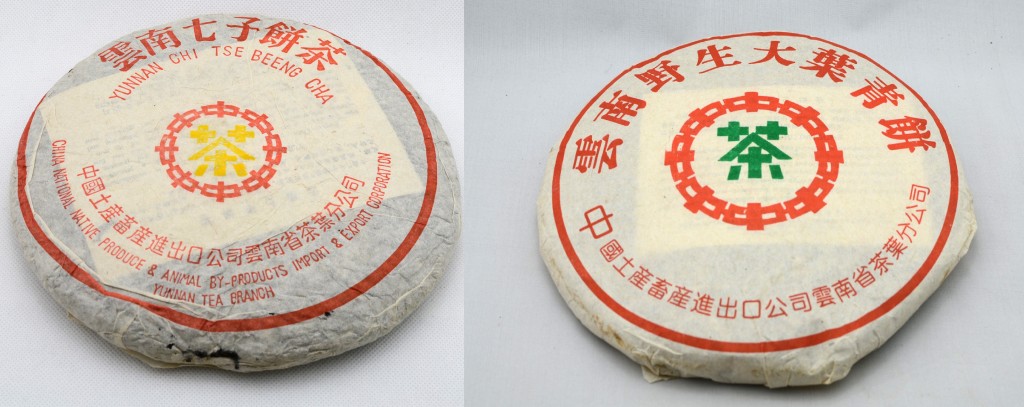Editor’s Note: After the episode on the 1997 CNNP 7581 (acquired via Yunnan Sourcing) (a good tea) we received several emails showing other options for late 1990s 7581. Some were drastically cheaper and others were more expensive. Such inconsistency in pricing indicates either faked age or drastic difference in quality/mark-up. Much of this inconsistency is associated heavily with the Zhong Cha brand.
Established in 1949, CNNP, or Zhong Cha, is one of the oldest, most classical pu’erh brands. CNNP wrappers are perhaps the most iconic, featuring the tea character surrounded by the Zhong (China) character. This logo is found on the majority of pu’erh beengs from the 1950s to the 1990s, including all of the famous pu’erh vintages from that time period. Productions in the 2000s used the same logo and similar wrapper as the original Zhong Cha wearing cakes printed in 1951, Still, the brand and the label on its own means very little in terms of a quality product. Far less than a consistent Menghai or Xiaguan product. In the opinion of many, these labels have become increasingly watered down over time but neither has fallen as far as the CNNP brand. In fact, contemporary CNNP of the last 20 years is almost renowned for its inconsistency.
Note #1: Kunming tea factory (#1 Factory) is also closely associated with CNNP. However, they are not quite one and the same. Kunming Tea Factory is one of the most notable factories that has operated under the CNNP brand.

1949-1980s, State Ran, Claim to Fame
During this period, all pu’erh factories were state owned and operated under the CNNP Zhong Cha brand. Before this in the early parts of the 20th century, pu’erh production was centered around Yiwu and the six famous tea mountains. Many of the most famous shops in Yiwu during this time period were small family run operations. However, the 1940s and 1950s ushered in a very different, new era for China. The total amount of tea businesses was significantly reduced and production was dominated by a few big factories (Kunming Tea Factory, Menghai Tea Factory, Xiaguan) all of which produced tea under the Zhong Cha label. Famous teas like the Red Mark, Blue Mark and Yellow Mark were all produced during this period.
Summed Up: Majority of pu’erh produced under Zhong Cha label. Includes Menghai, Xiaguan, etc.

Late 1980s-2000s
During the late 1980s as China began to privatize, restrictions loosened up and the pu’erh industry began to decentralize. This shift meant a couple things. While the pu’erh scene was still big-factory dominant, smaller factories began to sprout up. These companies (including the big factories) paid CNNP to use the famous Zhong Cha, similar to how a franchise works. Meanwhile, Menghai and Xiaguan began to establish their own brands. Over this time period, the Zhong Cha label was slowly phased out of Menghai and Xiaguan productions in favor of their own individual branding. Many of these new smaller factories (as well as the Kunming Tea Factory) didn’t bother to build up their own brand opting to instead use the Zhong Cha.
Summed Up: Big factories have a decreasing amount of pu’erh produced under the Zhong Cha label. New/smaller + Kunming Tea Factory use Zhong Cha.
Quality Control?? + 2007 Bubble Burst
From the 1990s onwards, pu’erh production began to ramp up more and more to keep up with ever-increasing demand. Less tea from big, reputable factories was being made and more by new, smaller producers. While the new producers didn’t all make poor quality tea, the end-result was an extremely inconsistent product all marketed anonymously under the Zhong Cha label. Eventually, there was a market realization that the CNNP label had sold their label and brand without any form of quality control or quality assurance. Many had speculated on the Zhong Cha brand and as the quality was questioned it inevitably played a role in the pu’erh bubble burst in 2007.
During this time, Xiaguan and Menghai exercised stronger far tighter quality control on their products. Although the efficacy of the contemporary teas from these two factories have been called into question, they are still generally recognized as reliable and consistent brands. This is also despite the myriad of Menghai fakes that have littered the market.
Note #1: When the bubble burst, nearly all tea went down significantly in price but perhaps the largest impact was felt on CNNP brand tea. Another big loser in the pu’erh bubble was Six Famous Tea Mountains. The quality of their products was also called into question.

What does it mean for the consumer, the bargain hunter?
While for some the Menghai Tea Factory and brand stands for a reliable product (also debatable). CNNP stands for the opposite. Occasionally good, often mediocre and generally very inconsistent. The end result is ironic and now CNNP offers much cheaper tea, absent of the label cost of other brands. Unsurprisingly, aged CNNP from the 1990s is considerably cheaper than its Menghai or Xiaguan counterparts.
Note #1: Because of the lack of information and generally unreliability of CNNP it is usually very difficult to track back the origin of the base material for the tea. The CNNP wrapper doesn’t even mention the year!
Note #2: It is no coincidence that many western vendors have created their selection with a number of CNNP labeled “Tiepai” (pasted label) pu’erh cakes. These cakes or teas without wrappers offer some of the better bargains in pu’erh as the anonymity of their wrappers makes them hard to resell.
Common Teas to be found under Zhong Cha: 7581 Bricks, Red Mark Cakes. Similar to many of the teas under the Zhong Cha label, these recipes have a high-degree of instability and inconsistency.
Further Reading: CNNP – Life in a Teacup


Leave a Reply